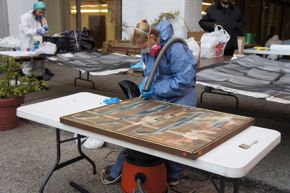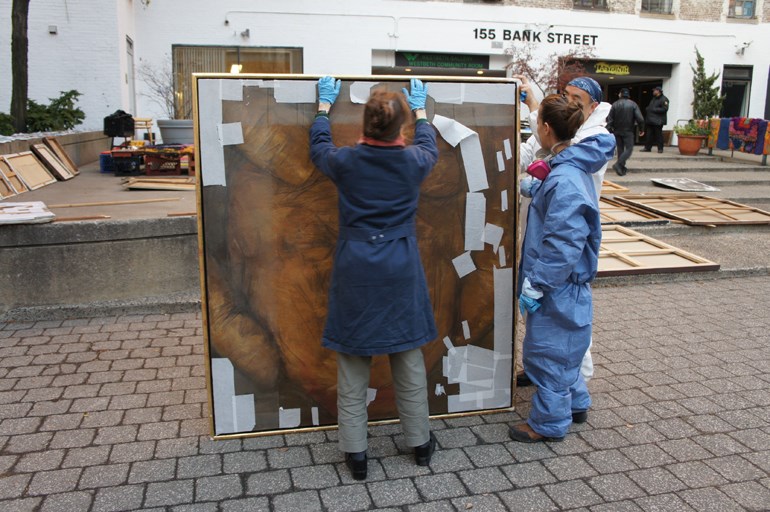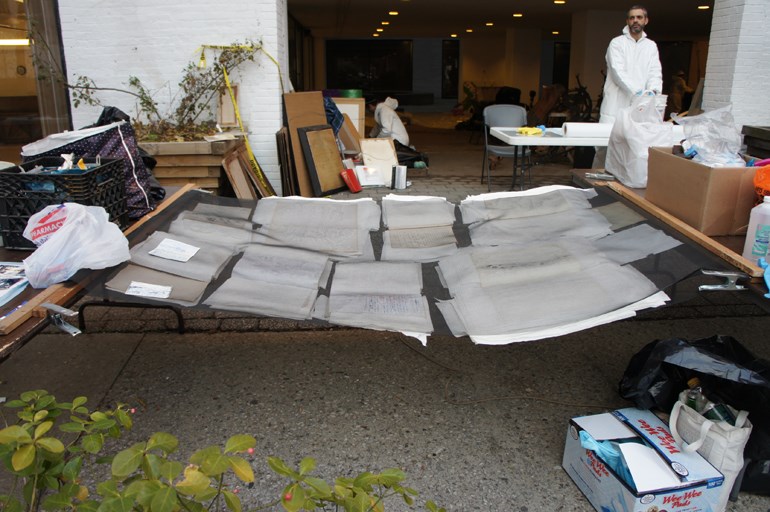Saving Art in the Wake of Hurricane Sandy December 12, 2012

Conservation volunteers removed debris and mold to prevent further damage to a painting and archival materials at the Westbeth site.
Art conservators worked with residents of Westbeth to stabilize lifting paint and clean artwork during salvage efforts.
Working with wet objects structural stability and mold was a concern. Here conservators moved a damaged stage prop in order for it to dry.
Arresting mold growth was a high priority after collections are removed from water. Here conservators can be seen spraying a 70% ethanol solution to kill mold on Noguchi sets and props for the Martha Graham Dance Company.
Basement flooding at the Westbeth Artists Housing complex storage and studios after water was pumped out.
Resourcefulness paid dividends with this makeshift arrangement for drying documents and works of art on paper.
Hurricane Sandy hit the U.S. East Coast just before Halloween, affecting artists and arts organizations in unprecedented ways. Steve Pine, from the MFAH Conservation Department, volunteered to go to New York City to assist with recovery efforts. He shares his insights.
After Hurricane Sandy made landfall in New York and New Jersey, significant flooding of low-lying areas resulted in a surprising degree of damage. Personal property and loss of life caused by the storm led to large-scale rescue and salvage efforts on the part of government offices and communities in the region that still continue. The arts community in the New York metropolitan area was devastated and is finding national support to salvage and restore damaged private and public collections.

The American Institute for Conservation (AIC) is collaborating with the New York Alliance for Response and the New York City Department of Cultural Affairs to bring expert resources to assist museums, galleries, individual artists, and performing-arts groups. Several foundations and allied arts groups (including Sotheby’s and the Andy Warhol, Robert Rauschenberg, and Lambent foundations) have stepped up with donated funding dedicated to supporting this citywide recovery. MoMA and its conservation staff responded quickly, hosting a workshop for artists and conservators based on established protocols for working with and preserving water-damaged artwork.
As team leader for AIC-CERT, I worked with art conservators from New York, California, Florida, Maryland, and Pennsylvania, responding to requests from artists and institutions for support and advice. On-site consults with artists and galleries in the Chelsea and Dumbo (Down Under the Manhattan Bridge Overpass) areas in particular focused on salvage techniques under stressful conditions for the full range of collections materials, helping move damaged collections to triage and alternative storage; communicating with commercial salvage contractors; and providing hazmat equipment and training for volunteers to work safely with mold and flooding contamination.

Preparing for an extended recovery program, I represented the stakeholder organizations by assessing potential salvage and storage sites for New York artists. Three large commercial properties in Brooklyn—ranging from in size from 7,000 to 20,000 square feet—were offered as donations to the recovery effort with the intent of creating a safe temporary space to repair damaged art under the supervision of trained art conservators. Negotiations and conference calls continue on that front as the collaborating institutions prepare for the next phase of support.
While additional teams are deployed to address the immediate needs of the arts communities in the area, I continue to respond remotely by phone to artists’ questions about restoration options as they move from the salvage phase into reclamation and repair of their work.





